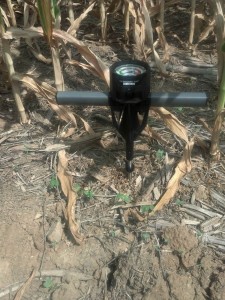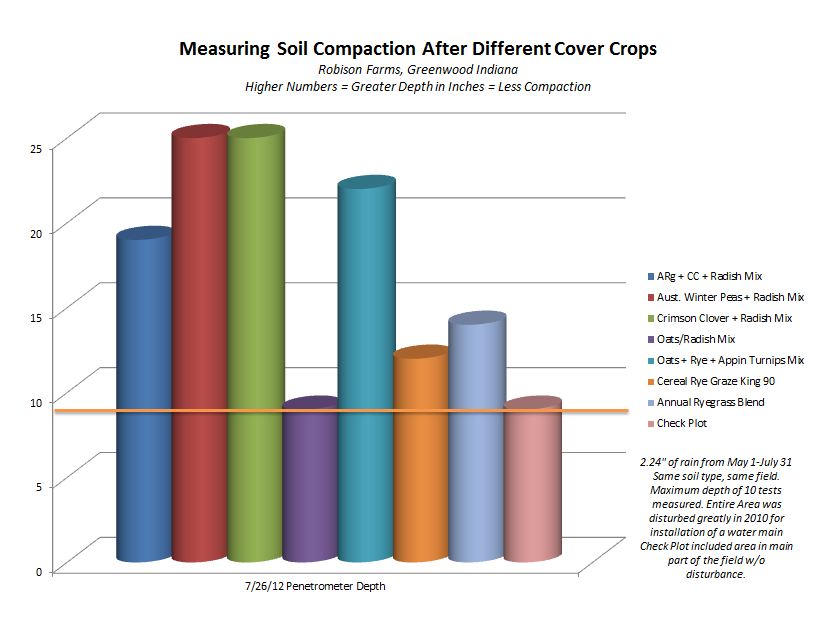My brother, Don Robison, from Robison Farms in central Indiana, has been doing a significant amount of research in our fields where we had our cover crop test plot in 2011-12. One part of the research that Don conducted was comparing compaction ratings in each different plot area and also in a check area. In each plot Don did a number of compaction readings using a penetrometer. He threw out any “odd” readings (like readings of 3.5″ deep) and reported the average of how deep the penetrometer was able to get. He followed the directions from the penetrometer company to properly record the data. The results were compelling…and interesting.
(The “Y” Axis on the chart above indicates inches deep. The deepest the penetrometer would go is 25″.)
Observations:
- The previous crop was soybeans and this field has been no-tilled for most of the past 20 years.
- The plot area had been disturbed three years ago when a water line was installed by the county
- The check plot area was NOT disturbed by the installation of the water line
- No-till alone does not appear to reduce compaction.
- We know from root pit digs that cover crops can put down deep roots
- Plots with legumes and cover crop radish had the least compaction – both going the full depth that the penetrometer could go.
- None of the peas, crimson clover, turnips, nor radishes were very big last fall…but they did have deep roots
- The Pea + Radish plot has been the most “mellow” all season long – including when digging roots, it by far has the best soil texture in the field
- The peas and crimson clover both survived the winter very well
- Not all plots with Radish had less compaction (Oats and Radish had similar readings as the check plot)
- Plots with Annual Ryegrass did not rank as high as some other plots, which was surprising
- While the oats + Radish plot had a more shallow compaction point – it also had a high chlorophyll reading most of the year- showing excellent plant health compared to some of the other plots – and considerably better the the check (data to come in a future post)
- The plot with Oats + Winter Cereal Rye + Turnips is impressive. For a “scavenger only” plot – that did not include a radish or annual ryegrass – it had very, very good ratings
- There were multiple earthworm holes and mounds (and a few worms too) in the cover crop plots – more than in the check plot (no-till with no cover crops present)
- A special thanks to The CISCO Companies for providing the equipment and the seed to conduct this study.


Would you think that the radish/winterpeas mix could penetrate our coastal plains hardpan in South Carolina? That is our main problem to solve in order to leave our soils undisturbed by iron and able to grow corn, peanuts, and cotton
John,
I’m not sure but I would certainly believe so. I have seen cereal rye grow through lake-bed soils in NW Ohio that I could not believe and radishes grow through “rock-hard” clay soil in NE Indiana. The peas continue to surprise me of how they make the soil so mellow. They don’t have the same deep roots as crimson clover but they are a great soil conditioner. It sure would be worth looking at that mix. Up here in the eastern corn belt a mix of 30# peas and 5# radishes seems to be the right formula to use.